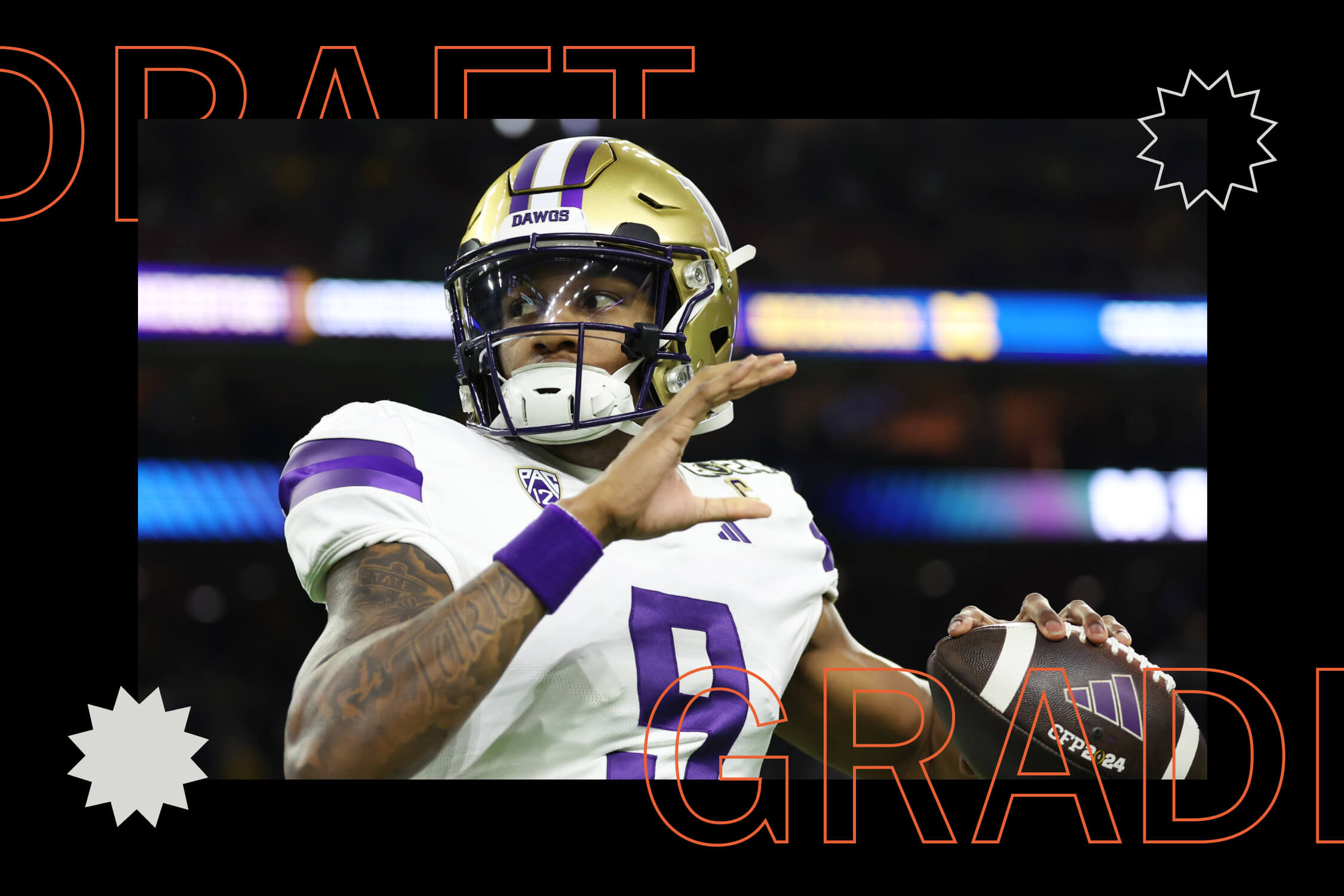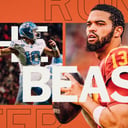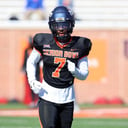
Welcome to The Athletic’s pick-by-pick grades for Round 1 of the 2024 NFL Draft. We broke down every selection as the drama unfolded throughout Thursday night. Which teams found the prospect (or prospects) they needed? Who might regret their decision down the line?
Of course, we won’t have full, accurate answers to those questions for a few seasons, so our grades tried to take everything into account — pick value, trade costs, what the board looked like at the time of the selection and so on.
Here’s how everyone did:
(Note: Scott Dochterman provided grades for odd-numbered picks, Nick Baumgardner for even-numbered picks.)
NFL Draft 2024 tracker: Live blog, pick-by-pick grades and analysis
Big board best available: Who’s left from Dane Brugler’s Top 300?
Full draft order: Team picks for all 257 selections
“The Athletic Football Show”: Watch live reaction to the draft
There was only one rational path for the Bears to take, and they took it. With the top pick and a shot at Williams in hand, the Bears practically gave away well-liked former first-rounder Justin Fields earlier this offseason. This selection is the right choice at the right time for a franchise that hasn’t had a starting Pro Bowl quarterback since Sid Luckman in 1942. In short order, Williams (6-foot-1, 214 pounds) could be just the third Pro Bowl QB overall for the Bears in the Super Bowl era.
The 2022 Heisman Trophy winner can lead in multiple ways and make every throw from any position, including on the run. He didn’t throw an interception on third or fourth down during his USC career and is seemingly in control in tight situations. He does need to work on fumbling issues (33 overall and 16 lost during his college career, counting his first season at Oklahoma).
Grade: A

GO DEEPER
NFL Draft 2024 ‘The Beast’ Guide: Dane Brugler’s scouting reports and player rankings
It’s a new day in Washington D.C., now complete with a new QB. The 2023 Heisman Trophy winner, Daniels threw for 57 touchdowns to just seven picks in two years with the Tigers. He was one of the most improved players in the country during that stretch, too. An electric dual-threat passer with elite speed and short-area quicks in space, Daniels is unique and built for the modern game.
Some had Daniels a bit behind Drake Maye, though Daniels was worthy of a top-five choice this year. He has to be better against pressure and show he can throw inside the numbers, but he’s a serious playmaker who knows how to lead and brings with him a terrific work ethic.
Grade: A
The Patriots had options to trade down and perhaps stockpile talent at other positions, but their need at quarterback was greater. It’s a risk for New England, which couldn’t turn Mac Jones into a success, but it’s the right one.
When one looks at Maye (6-4, 223), they can see a carbon copy of the prototypical quarterback. There’s no question he has every tangible quality NFL personnel seek at the position, and his intangible gifts are obvious, as well. But his career trajectory will tilt upward if he can slow down a bit and make all of the plays. That’s going to require patience from the Patriots’ front office, coaches and players — and from Maye himself.
Considering his potential, Maye may have the most upside of any quarterback in the draft. That’s worth betting on.
Grade: A
The Cardinals have more capital to work with in this draft than any other team, and GM Monti Ossenfort gets things started with a bang by adding a great new friend for Kyler Murray. Harrison is arguably the most complete receiver prospect we’ve seen in a decade, with no true holes in his game. His ability to adjust to off-target throws — deep and underneath — is unmatched in this class.
A trade down definitely could’ve made Arizona’s draft haul even greater, but the Cardinals needed a wide receiver. There’s nothing wrong with sticking and taking the best player at an area of need. Great pick, and possibly an elite one.
Grade: A
Jim Harbaugh built Michigan into a national champion by fortifying its offensive line. He now will attempt to do the same with the Chargers. Harbaugh had plenty of opportunities to trade down, but starting his tenure with an elite left tackle was too much to discard.
After beginning his career as a tight end, Alt slid to left tackle midway through his freshman year at Notre Dame and never vacated the position, making 33 consecutive starts. He has the requisite arm length (34 1/4 inches), quickness (1.73-second 10-yard split), strength and natural ability to play left tackle for a decade-plus in the NFL. His father, John Alt, was a stalwart left tackle with the Kansas City Chiefs in the 1980s and 1990s.
Grade: A-minus
Nabers is an electric playmaker and arguably this class’ most dangerous ball carrier in space. An incredibly smooth and explosive athlete with great ball skills, Nabers was an instant contributor in the SEC for LSU and made 161 catches (playing with Jayden Daniels) the last two seasons. There were some scouts who had Nabers ranked ahead of Harrison — he’s that good.
The Giants have questions about Daniel Jones, to be sure. But they still have so much work to do that bringing a first-round QB in to compete for the job wouldn’t have made much sense. Nabers is an awesome talent and will instantly make one of the slowest offenses faster. This is a sensible, efficient and potentially explosive draft pick.
Grade: A
Most receptions of 20+ yards over the last 5 years in CFB:
34 – Malik Nabers (2023), Ja’Marr Chase (2019)
33 – Jordan Addison (2021)
32
31
30 – DeVonta Smith (2020)
29
28
27
26 – Rome Odunze (2023), CeeDee Lamb (2019) pic.twitter.com/oGF9RR8ohY— Dane Brugler (@dpbrugler) December 1, 2023
Tennessee absolutely needed a tackle as part of its offensive line reconstruction, and Latham has the potential to become an anchor for a decade. But is this the right spot for him? He was a right tackle at Alabama, and the Titans have a glaring need at left tackle. If Latham can make that move, it’s perfect. If not, this becomes a question mark.
Perhaps the most powerful player in the draft, Latham caves in defenses when run blocking. He’s massive (6-5 1/2, 342) with an 85-inch wingspan and 35-inch arms. A second-team All-American last fall, Latham didn’t miss a game and made 27 consecutive starts at Alabama.
Grade: B
And we’ve found our first stunner. Months after signing Kirk Cousins to a four-year deal worth up to $180 million, the Falcons go quarterback — and not J.J. McCarthy. Instead, it’s Penix, the nearly 24-year-old lefty. This is beyond interesting and, for Cousins, perhaps feels like a bit of deja vu from his days alongside Robert Griffin III.
Penix is a talented passer, to be sure. But there are questions here: his age, his health (he’s had multiple leg injuries), his consistency as an accurate passer and the fact Cousins is making a fortune. Penix doesn’t throw the ball over the middle with nearly the same confidence he shows outside the numbers. He’s going to have to figure out better answers versus pressure.
But his arm talent is outstanding, and it’s hard to bet against his perseverance. At No. 8, though? This feels a reach. Time will tell.
Grade: C
The Falcons took Michael Penix Jr. with the No. 8 overall pick.
The crew reacts on The Athletic’s live Draft show: https://t.co/cHhKHwelvy pic.twitter.com/eI1PqP2Jbb
— The Athletic NFL (@TheAthleticNFL) April 26, 2024
9. Chicago Bears: Rome Odunze, WR, Washington
The Bears have remade their offense in two short years, and by selecting Odunze after getting Williams at No. 1, Chicago may have changed the trajectory of its franchise for perhaps the next decade. With Odunze, Keenan Allen and DJ Moore working with Williams, the Bears have a potentially explosive offense. (Yes, let that sink in.)
The FBS leader in receiving yards last year (1,640), Odunze (6-3, 212) has great size and length that eventually should lead to him playing X receiver. He’s fast and explosive (32 catches of 20-plus yards last year). With very good speed (4.45-second 40-yard dash) and a wide catch radius, Odunze can make big plays down the field in contested situations.
In most drafts, he’d be the top receiver chosen and among the favorites for Offensive Rookie of the Year.
Grade: A-plus
What an offseason for the Vikings. After making a big pre-draft move, Minnesota was able to land a quarterback (and climb one spot) without surrendering its other first-round pick. (The Vikings sent Nos. 11, 129 and 157 to the Jets for this spot and No. 203.) All this mere months after Minnesota lost Cousins, its previous franchise QB.
McCarthy’s skill set has had NFL evaluators on alert for three years, though his work inside Michigan’s run-heavy offense made it very difficult to totally project what he’ll be immediately in the NFL. A very tough, aggressive passer in the mold of his former coach (Harbaugh), McCarthy’s an unquestioned winner (63-3 record since high school).
He may need to learn behind Sam Darnold for a minute, but this is a great long-term fit with Kevin O’Connell — and he could be more ready early on than some believe.
Grade: A
11. New York Jets (from MIN): Olu Fashanu, OT, Penn State
In the debate between need and want, the Jets went with the latter, and in doing so laid a foundation for the future up front. Fashanu likely will get thrown in as a rookie and could become an anchor for the next decade. As tempting as tight end Brock Bowers had to be here, the Jets made the right move. Fashanu is a left tackle, and that’s important for the Jets’ future.
Massive and explosive, Fashanu was a force for the Penn State offensive line the last two seasons. He considered leaving for the NFL after the 2022 season but chose to return and became a consensus All-American, the Big Ten’s Offensive Lineman of the Year and a finalist for the Campbell Trophy (the “Academic Heisman”).
Grade: A
The 2024 quarterback thirst is very real. Make it six QBs gone in the top 12.
This one, somehow, didn’t feel as shocking as the Penix pick — in part because that already happened. There’s a lot to like about Nix. In fact, the conversation surrounding the former Oregon passer is very similar to the one about Penix: He’s older and comes with physical limitations. Unlike Penix, though, Nix played in a very college-style offense at Oregon.
But Sean Payton knows quarterbacks, and Denver can’t go anywhere without one. The fit here does work, as Nix’s quick release and poise should fit pretty well with Payton’s scheme. Still, as with the Penix pick, it sure feels like Denver could’ve gotten more value here. It’s a bold move, if nothing else.
Grade: C-plus
To justify this pick, you have to think of Bowers as a pass catcher, not strictly as a tight end. When you consider that his versatility will allow him to play alongside last year’s second-round tight end, Michael Mayer, then it could be a major coup. The Raiders will need to work heavily out of 12 personnel to make this fit. It’s a great value, but did Bowers fill a need?
That said, Bowers is a steal at this point. The first two-time Mackey Award winner as the nation’s top tight end, Bowers is a mismatch wherever he lines up — inline, slot, backfield or out wide. Few pass catchers find a way to get open like he does, and his 8.5 yards-after-catch average over his three seasons at Georgia is a rare number for his position. He was the best player on the field every time he stepped on it.
Grade: B-plus
The rush on quarterbacks really helped out a lot of teams in the back half of Round 1. It helped the Saints here, in a big way. Fuaga was a top-two tackle on some NFL boards, top-three on several more. And there wasn’t a team in the league more in need of tackle help than the Saints, who just landed a road grader.
Fuaga (6-5, 324) was dominant at times on the Beavers’ right side last season, as arguably the best run blocker in the country. This is a culture pick as much as anything else, too — Fuaga will help improve the team’s overall toughness up front. Great value for the Saints in the middle of the first round.
Grade: A
It took 15 picks, but Indianapolis finally selected this draft’s first defensive player. And the Colts got a good one in Latu, who might have been the best defensive player in college football last season (13.0 sacks, 21.5 tackles for loss). Indianapolis, meanwhile, ranked 28th in scoring defense, 24th in run defense and allowed 22 rushing touchdowns.
Latu should help in every area, and he’ll also entere the NFL as one of its best stories. His NFL dream nearly was derailed by a neck injury in 2020, which caused him to miss two seasons and led him to medically retire while at Washington; he was cleared to play again after surgery, then transferred to UCLA in 2022.
The only question is whether a cornerback might have been a more impactful pick, but Latu is a keeper.
Grade: B-plus

GO DEEPER
How star OLB Laiatu Latu masters the unique craft of pass rushing — and why
Good things come to those who wait? Sure, we’ll go with that. The Seahawks have had a need right in the middle of their defense for what seems like several years now. And after early runs on quarterbacks and tackles pushed the top defenders down, Seattle hit a whopper by landing the top interior defensive lineman in this draft.
Murphy, who can play nose or three-tech, is extremely powerful and explosive with a lethal punch at the point of attack. A smaller body in the Aaron Donald mold, Murphy is all gas off the line of scrimmage, and his natural leverage makes him a bear to deal with inside. Some teams valued him as a top-10 prospect in this draft. This is terrific value for new Seattle head coach Mike Macdonald.
Grade: A
17. Minnesota Vikings (from JAX): Dallas Turner, Edge, Alabama
After losing Danielle Hunter in free agency, the Vikings needed some pass-rush punch. So, Minnesota jumped up six spots (sending Nos. 23 and 167 plus third- and fourth-round picks in 2025 to Jacksonville) and grabbed perhaps the draft’s most athletic pass rusher. Turner was considered by many to be a possible top-10 pick. Edge was a need for the Vikings, too, probably equal to cornerback.
Turner (6-2, 247) was a consensus first-team All-American last season after posting 11.0 sacks, 15.5 tackles for loss and two forced fumbles. He solidified his first-round status with an impressive combine (4.46 40-yard dash, 40 1/2-inch vertical, 34 3/8-inch arms). He should replace Hunter quite nicely.
Grade: A
Mims might be the freakiest athlete in the entire draft. The 6-7, 340-pounder has 36 1/8-inch arms, a near 87-inch wingspan and 11 1/4-inch hands. He’s simply a massive human. He also runs like a tight end and can deliver a punch that will decleat anybody. His ceiling is more or less out of this world.
His floor, however? That’s another conversation. Mims started just eight games over three years at Georgia, missing six last year with an ankle injury. A right tackle only in college, Mims still makes a ton of youthful mistakes with his eyes and feet and will fall off blocks far too easily. However, with time in an NFL system and the right offensive line coach, he could develop into a true star.
Grade: B-plus
The Rams lost Aaron Donald, one of the greatest defensive linemen in NFL history, and needed to find some way to replace him. Verse likely won’t equal what Donald brought (nor would anyone else), but he was a nice choice for a team that hadn’t made a first-round pick since 2016. Chop Robinson might be more explosive with a higher upside, but Verse was more productive in college.
A workmanlike technician with a motor, Verse (6-4, 254) became an All-American after beginning his career at Albany as a no-star recruit. He played three seasons in the FCS (including one as a redshirt), then transferred to Florida State and posted back-to-back nine-sack seasons. Although he may not wow observers physically, Verse boasts one of this class’ top work ethics, which will serve him well in the NFL.
Grade: B
FSU’s Jared Verse just had the best two-game stretch of his career the last two weeks vs. Florida and Louisville. Dominated both games.
17 pressures, 6.0 TFL, 4.5 sacks, 1 FF pic.twitter.com/fu0hdyRCX9
— Dane Brugler (@dpbrugler) December 3, 2023
One of the most versatile linemen in this draft, Fautanu is bit oddly shaped for his position — in a good way. At 6-3, 317, Fautanu plays low to the ground but also has great length (34 1/2-inch arms). A left tackle at Washington, Fautanu is athletic and a possible five-position prospect. The Steelers announced him as a tackle, but he also could play guard and maybe even center.
The Steelers need help in the middle of their offensive line, so it won’t be a shock if he gets a shot there. If that doesn’t work out, though, he could play opposite Broderick Jones or inside at guard. This is a great pick and an outstanding value.
Grade: A
With both of its starting edge rushers (Jaelan Phillips and Bradley Chubb) coming back from season-ending injuries, Miami needed reinforcements, even if just to rotate. The Dolphins picked up perhaps the best player available, and one with plenty of upside. They could have used an offensive lineman, but an earlier run at that position helped nudge them toward Robinson.
One of the most feared pass rushers in the Big Ten, Robinson commanded attention last year on Penn State’s elite defense. He picked up just four sacks and 7.5 tackles for loss in 10 games, but he was regularly double teamed in passing situations. The 6-3, 254-pounder has elite get-off at the line of scrimmage, which was validated by his 4.48 40 at the combine.
Grade: B-plus
Many wondered if Philadelphia might move up to address its obvious need at corner. Instead, with six quarterbacks going in the top 12, the corners fell to the Eagles.
One of the humblest players in the draft, Mitchell turned down big NIL money offered by SEC schools to stay at Toledo and finish his degree. As a player, he’s big, long and extremely fast — Mitchell burned a 4.33 at the combine, posted a 38-inch vertical and a broad jump of 10 feet, 2 inches, and was downright dominant at the Senior Bowl. He improved every day at Toledo and wound up with a whopping 52 passes defended over three years.
For Philadelphia, this couldn’t have gone better.
Grade: A

GO DEEPER
NFL Draft’s quiet star was built for this moment — and he’s rising up draft boards
After losing receiver Calvin Ridley in free agency, the Jaguars needed a replacement who could stretch the field and develop into a No. 1 option for quarterback Trevor Lawrence. Thomas might cover both needs. He’s got tremendous athletic ability and is capable of catching double-digit touchdown passes as a rookie.
At LSU, playing alongside Nabers, Thomas (6-3, 209) was a third-team All-American and led the country in touchdown catches (17) last season, while posting 68 receptions for 1,177 yards (17.3 yards per catch). At the combine, he ran a 4.33 40, the second-fastest time among all receivers.
Grade: A-minus
The hometown fans were concerned that the Lions might trade out of the first round. But as the corners started falling Thursday night, GM Brad Holmes couldn’t help but pick up the phone. Detroit moved up five spots (sending Nos. 29 and 73 to Dallas for No. 24 and a 2025 seventh-round pick) and filled a big need.
Like the Eagles, the Lions landed outstanding value in the 20s — Arnold and Mitchell were pretty clearly the top two corners in this draft. For Detroit, this was also a perfect fit for the team’s established culture. Arnold is a confident corner who plays with swagger, loves to work, loves tough coaching and loves to win. Arnold will reunite with former Alabama teammate Brian Branch in a new-look Detroit secondary. Another great value pick.
Grade: A
The Packers had needs both along their offensive line and in the secondary. They opted for Morgan rather than addressing that secondary, which intercepted a league-low seven passes last season. Morgan certainly is a first-round prospect, but Green Bay missed a chance to improve at its most vulnerable spot.
Largely considered a guard, Morgan (6-5, 311) started 37 games over five seasons at Arizona. His arm length (32 7/8 inches) probably will keep him inside, but he could kick outside, if necessary. He should be able to start right away at right guard.
Grade: C
Up there with Fautanu among the most versatile linemen in this class, Barton gained college starting experience at both center and tackle. He’ll most likely get a shot inside with the Buccaneers, who announced him as a center (and are in need of a center) but also could use a boost at guard.
One of the most powerful linemen in the class, Barton doesn’t have ideal length to play outside in the NFL. His power and IQ (along with his feet) are more than enough to be terrific inside, though.. He’s probably an interior-only lineman in the NFL, but he has a chance to be very good for a long time.
Grade: A-minus
27. Arizona Cardinals: Darius Robinson, Edge, Missouri
The Cardinals ranked last in run defense, 31st in scoring defense and allowed 4.7 yards per carry last season. They needed a talent infusion along their defensive line, and Robinson should provide it, likely as a 3-4 defensive end.
The best word to describe Robinson is “massive.” With a frame that could lead him to an edge or interior role, Robinson (6-5, 285) has positional flexibility up and down the line. He also boasts an extraordinary wingspan (84 3/8 inches) and incredible hand size (10 5/8 inches). At Missouri, Robinson was productive (8.5 sacks and 14 tackles for loss) and earned first-team All-SEC honors. He also was considered the leader on a team that beat Ohio State in the Cotton Bowl, and he was voted the practice player of the week at the Senior Bowl.
Grade: A-minus
Welcome to the Darius Robinson show.
Efficient arm-over vs. Tyler Guyton. pic.twitter.com/KM3VMUEDVJ
— Dane Brugler (@dpbrugler) January 31, 2024
28. Kansas City Chiefs (from BUF): Xavier Worthy, WR, Texas
Patrick Mahomes has yet to meet a player he can overthrow. We’ll see if Worthy gives him a run for his money.
The Chiefs moved up from the end of Round 1 — sending picks 32, 95 and 221 to Buffalo for Nos. 28, 133 and 248 — and snagged the fastest player in this draft. (Worthy set the combine record with a 4.21-second 40 earlier this spring.) This feels like a very good fit for Kansas City’s offense, and for Mahomes in particular, as Worthy is dynamic with the ball in his hands.
However, he’s also very small, at just 165 pounds. Whether or not he’ll be able to hold up with a high catch volume deep into a season is a fair question. Worthy can be inconsistent with his hands, too, and his play strength will limit some of what he can do a the next level. Was he a first-round prospect in this draft, especially with some of the talent still on the board? Maybe. But it’s tough to hate the fit.
Grade: B
“If he hits, he’s DeSean Jackson. But that’s a big if.”@dpbrugler on Patrick Mahomes’ newest weapon Xavier Worthy 👀https://t.co/cHhKHwelvy pic.twitter.com/I6zjfitmp7
— The Athletic NFL (@TheAthleticNFL) April 26, 2024
Dallas had big holes at two spots, center and right tackle, and filled the one on the outside here. It’s an upside move, as Guyton could start at right tackle and perhaps flip to left tackle in time. If he reaches his potential, he could form a solid tandem with Tyler Smith.
Still raw and developing, Guyton started 14 games at Oklahoma — 13 at right tackle, one at left tackle — before declaring for the draft. He also started one game as a tight end at TCU in 2021. Guyton (6-7 1/2, 322) has the requisite body for an NFL tackle (34 1/8-inch arms). It might take him some time, but his upside is immense.
Grade: B
One of the fastest players on the board (4.28 40 at the combine), Wiggins is quick off the line of scrimmage and also possesses excellent second-level speed — a combination that makes him incredibly difficult to beat vertically. Wiggins’ length (6-1 with almost 31-inch arms) is also a plus. He got his hands on a combined 25 passes over the last two seasons at Clemson.
The question marks here are size and power. Wiggins weighed 173 pounds at the combine, before checking in at a reported 182 pounds at his pro day. He was mainly an outside-only corner in college, and it remains to be seen how much he can give the Ravens against the run. He’s a first-round talent in this draft, though, to be sure.
Grade: A-minus
This feels like either a reach or an insurance policy, in case Brandon Aiyuk ends up getting dealt. Pearsall will make some tough catches and could wind up running plenty of interior routes alongside tight end George Kittle.
A five-year veteran who spent three seasons at Arizona State and two at Florida, Pearsall (6-1, 189) built a reputation for his toughness and ability to haul in difficult catches. Last year with the Gators, Pearsall caught 65 balls for 965 yards (14.8 yards per catch) and four scores. As a junior, Pearsall averaged 20.0 yards per catch (33-661) with five scores. He also ran a 4.41 40 at the combine and had a 42-inch vertical jump.
Grade: B-minus
The Panthers moved up one spot (picks 33 and 141 to Buffalo for Nos. 32 and 200) to snag help for QB Bryce Young. A 6-1, 221-pounder with a 40-inch vertical, Legette is a powerful blend of speed (4.39 40) and explosion. He looks and runs a lot like Seattle star DK Metcalf.
There are concerns, however. Before his breakout 2023 season (71 catches for 1,255 yards and seven touchdowns), Legette had a combined 42 receptions over his previous four years. He’s also 23 years old and not yet a consistent route runner. But he is a credible deep threat who will provide help as a returner. Would Texas’ Adonai Mitchell or Georgia’s Ladd McConkey have been a better option here?
Grade: C-plus
(Illustration: Eamonn Dalton / The Athletic; Photo of Michael Penix Jr.: CFP / Getty Images)

